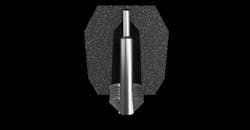Advantages of Collapsible Breaker Cores
Casting buyers continue to demand cast parts with thinner wall sections and more complex designs, which requires foundries to produce castings with more isolated sections -- and as a result they are required to adopt spot-feeding practices.
There has been incremental development and optimization of the ram-up sleeve application technology using a patented, collapsible metal breaker core design. The latest development is the result of applying experience gained in the area of spot feeding on high-pressure molding lines.
In the past 40 years the development of spot-feeding concepts was driven by foundries‘ individual technical requirements. Changes in the production process of foundries resulting for example in higher molding pressures had to be covered with adapted spot feeder sleeve designs.
Process cost pressure and increasingly complex casting designs demanded by the customers influenced the market for reduced feeder contact and footprint areas. As a result, solutions were developed to achieve the lowest fettling and cleaning costs, in combination with optimized yield.
Development of collapsible breaker cores -- In 2004 a new generation of spot feeders was launched, which addressed the foundries’ demands.
The concept of a collapsible metal breaker core provides two key advantages:
The molding pressure is partly absorbed by the collapse of the metal breaker core and compaction of the molding sand beneath it, enabling this concept to withstand higher molding pressures than other conventional solutions.
The feeder neck height is reduced during molding, helping to ensure that the feeder neck remains open until after the casting solidifies.
In the last 15 years this feeder sleeve product range has proven to be a robust solution for many different foundries.
Latest spot feeder development – Beginning in 2015, a further development adopted the advantages of spot feeders with collapsible metal breaker cores, such as consistent knock-off areas, constant feeder volume, and excellent molding results. The new design made it possible to reduce the breaker core metal wall section, whereas these were still suitable for the use in high pressure molding applications. Also, the design was modified from a stepped to a grooved design.
The new sleeve concept allowed the combination of the metal breaker core with the feeder sleeve, without applying hot glue in a press fit operation. The breaker core itself rests on a small socket in the opening of the feeder sleeve. During molding the grooved part of the metal core is compacted and the main feeder sleeve body moves down toward the pattern plate, compacting the mold sand between sleeve and pattern plate.
After full compaction the major part of the metal breaker core is super-heated by the high exothermic sleeve material. As a result, the metal neck surface in direct contact to the mold sand is reduced by 50% compared to the prior stepped design.
Several field trials proved an equivalent or even better feeder neck pass-through performance compared to the existing concept with similar knock-off results.
Today, FEEDEX VAK is a solution that is used in a high number of iron casting applications.
The concept of collapsible metal breaker cores provides several critical advantages, such as consistent molding results even with highest molding pressures, as well as reduced footprint and neck contact areas.
Further developments have resulting in an improved design that provides excellent feeder neck pass-through characteristics. An extensive test program and field trials confirmed the technical validity of this concept.
Christof Volks is Foseco‘s international marketing manager for feeding systems. Contact him at [email protected], or visit www.foseco.com
